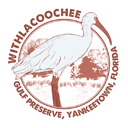 If you have walked the trails at the Preserve you may not have given lichens a second thought. Or perhaps mistaken them for another organism, like a moss. If this is the case, then you have missed out on wonders of the natural world.
If you have walked the trails at the Preserve you may not have given lichens a second thought. Or perhaps mistaken them for another organism, like a moss. If this is the case, then you have missed out on wonders of the natural world.
A lichen is not a single organism, but rather a mutualistic community of at least two different species: a fungus and a photosynthetic alga or cyanobacterium. Lichens can be divided into three principal body categories.
- Fruticose lichens are highly branched and can grow like shrubs.
- Crustose (crustlike) lichens adhere tightly to their substrate.
- Foliose (leafy) lichens are loosely attached and grow parallel to their substrate.

On a January 2020 Citrus Native Plant Society field trip lichenologists Ann DeBolt and Roger Rosentreter pointed out that all three lichen categories can be found on many substrates at the Preserve: on tree bark, on open soil, and on bare rock.
To learn more about lichens:
- Florida Lichen Field Guide (by Ann DeBolt, Roger Rosentreter, et al.)
- Lichen photographer and biologist Tim Wheeler (video)






 The Audubon Society has a free, award-winning field guide app. Versions are available for Apple iOS, Android, and Amazon Kindle. To learn more visit:
The Audubon Society has a free, award-winning field guide app. Versions are available for Apple iOS, Android, and Amazon Kindle. To learn more visit: